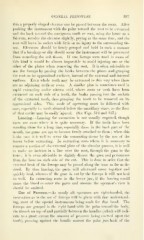Page 599 - My FlipBook
P. 599
GENERAL PRINCIPLES. 597
this a properly shaped elevator can be passed between the roots. After
pushing the instrument with the point toward the root to be extracted
and the back toward the contiguous tooth or root, using the latter as a
fulcrum, revolve the elevator slightly, prying at the same time, and the
root will leave its socket with little or no injury to the surrounding tis-
sue. Elevators should be firmly grasped and held in such a manner
that if a breakage or slip should occur the instrument will be prevented
from wounding the soft tissue. If root forceps were used in cases of
this kind it would be almost impossible to avoid injuring one or the
other of the plates when removing the root. It is often advisable to
use the forceps by passing the beaks between the plates and grasping
the root on its approximal surfaces, instead of the external and internal
surfaces. Even whole teeth may be extracted in this way when there
are no adjoining teeth or roots. A similar plan is sometimes used in
rapid extracting under nitrous oxid, where roots or teeth have been
extracted on each side of a tooth, the beaks passing into the sockets
of the extracted teeth, thus grasping the tooth to be removed on its
approximal sides. This mode of operating must be followed with
care, especially in teeth situated below the maxillary sinus, as the floor
of that cavity may be easily injured. (See Figs. 516 and 517.)
Lancing.—Lancing for extraction is not usually required, though
there are cases where it is quite necessary. If the teeth have been
standing alone for a long time, especially those in the back part of the
mouth, the gums are apt to become firmly attached to them ; when this
is the case it is well to sever the connecting tissue by the use of the
lancet before extracting. In extracting roots where it is necessary to
remove a portion of the external plate of the alveolar process, it is well
to make an incision in a line over the root, through the gum to the
bone ; it is even advisable to slightly dissect the gum and periosteum
from the bone on each side of the cut. This is done in order that the
external beak of the forceps may be passed along the bone as far as de-
sired. By thus lancing, the parts will afterward come together and
quickly heal, whereas if the gum is cut by the forceps it will not heal
so well. In extracting roots in the lower jaw, if the lancing would
cause the blood to cover the parts and obscure the operator's view it
should be omitted.
Use of Forceps.—As nearly all operators are right-handed, the
instruction as to the use of forceps will be given with that understand-
ing, most of the special instruments being made for that hand. The
forceps are grasped in the right hand with the palm toward the body,
the thumb on top of and partially between the handles (which will indi-
cate to a great extent the amount of pressure being exerted upon the
tooth), pressing against the handle nearest the palm just back of the


